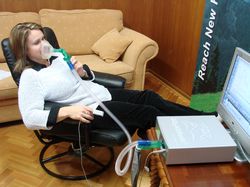Air has a delicate form of energy. It is an extensive element in the universe, within the human body & all the living creation. When talking about air’s energy for various functions of body, Hathayoga determines it has five functions. They are: 1) Prana : this energy functions from mouth to the heart in the breathing process.
2) Apan: Energy functions in the lower part of stomach & controls excretory system. 3) Saman: This energy fuels air to make digestive system to function. 4.) Udan: Energy that remains within chest region controls the air of food pipe. 5) Vyan: This energy pervades with in whole body & ensures separation of energy generated by air & food.
 There are four secondary Air or Pranas (energies) :
There are four secondary Air or Pranas (energies) :
A) Naga: this energy controls the eye lid movement plus regulates the pressure on the stomach
B) Krikal: this energy stops any outside particles entry into nostrils or throat by sneezing or coughing.
C) Devadutta: supplies additional & extra energy through yawning.
D) Dhananjaya: This energy remains in the body after the death and at times causes swelling in the dead body.
There are four different kinds of Pranayam:
Bahyavritti:
1) This one is done with easy posture as suitable for the conditions of the participant. Either in Padamasan or Siddhasana or sehaj asan or on a chair if unable to sit on the surface. Exhale all the air from lungs all at once. One should always sit in meditative
2) Perform mool, uddiayanand Jalander bandh – hold the breath as long as possible.
3) When you are urged from within resume the breathing, remove the bandhs and inhale gently.
4) Keep inhaling & without stopping exhale at once.
5)Repeat between 3- 21 times.
Abhyantar Vritty Pranayam: This pranayam is highly useful against asthma. & all the lung related difficulties. One becomes strong, energetic & full of
1) Sit meditatively & exhale completely. Exhale completely & inhale to the maximum capacity of the lungs. The lower part of abdomen should be drawn in. Preform the mool bandh& the Jalandhar bangh.
2) Retain the breath as long as possible and prior to breathing out remove the bandhs. Breath out as slow as possible.
Stambhavritti:
Sit in comfortable posture and start noting the natural breathing – hold it as long as possible chanting OM & do the same when breathing out. The yogi is in total control of his mind, thus, in tune with the Creator. The sense of the organs disappear in the pranas & pranas in self.
Bahyanter vishayakshepi:
This is an advanced state of Pranayam, practised by Yogis after plenty of experience. Here one has to concentrate the thoughts on total trust of God that all good will come under any situation. Both the air of inhaling & exhaling are are held as a stopper in the nostrils – that is both airs are stranded against each other for as long as possible.This interaction helps to control the mind & thus the sensory organs. The body becomes strong & mind is pure& ready for meditation. As a result the intellect is refined & sharpened. One becomes strong bodily & steady with total command over the sensory organs. One can reply to any sort of queries for complex subjects & make other understand the matter. While practising this pranayam one needs to focus between the eyes at mid point between the eyebrows







